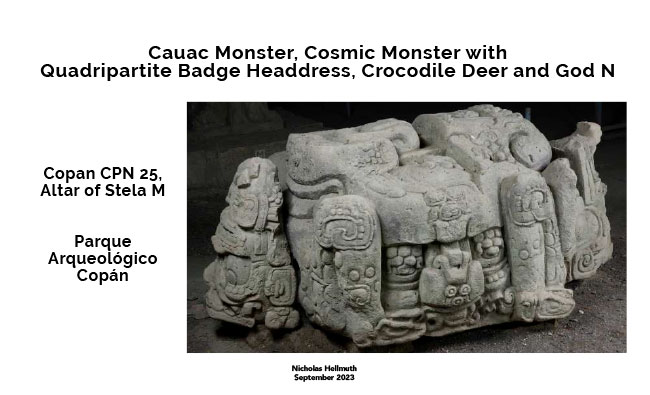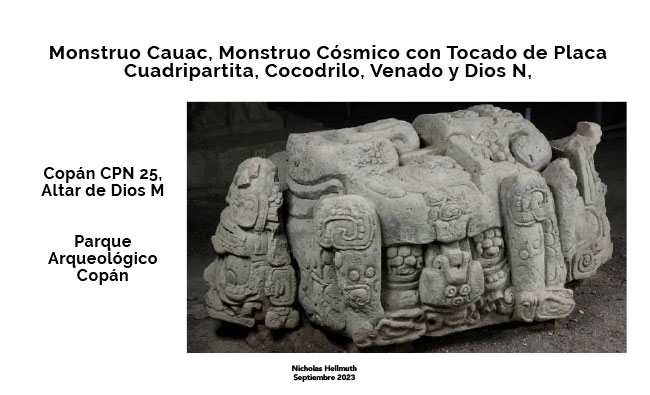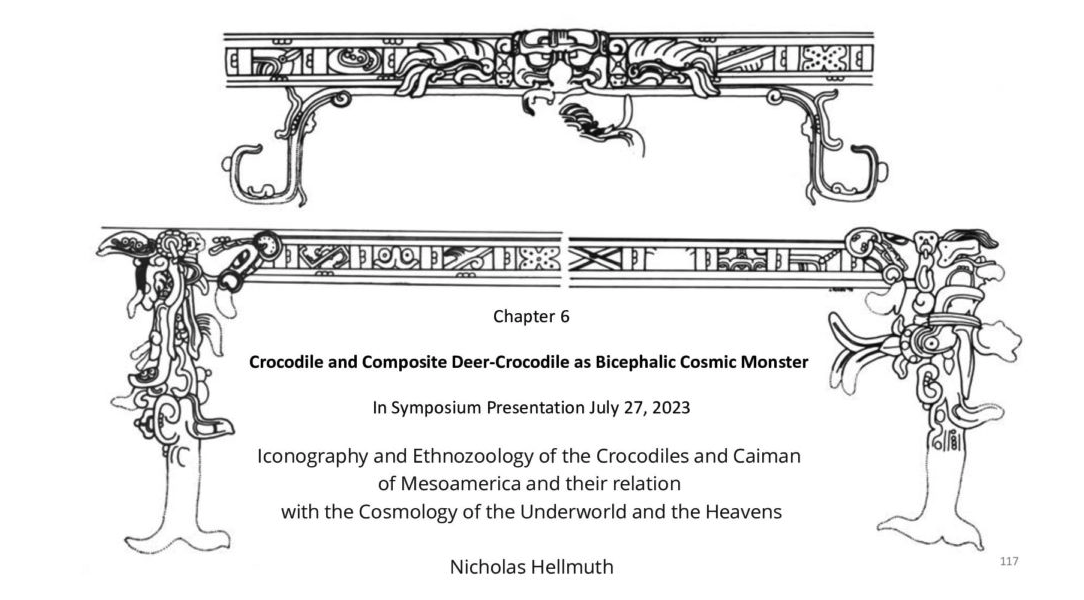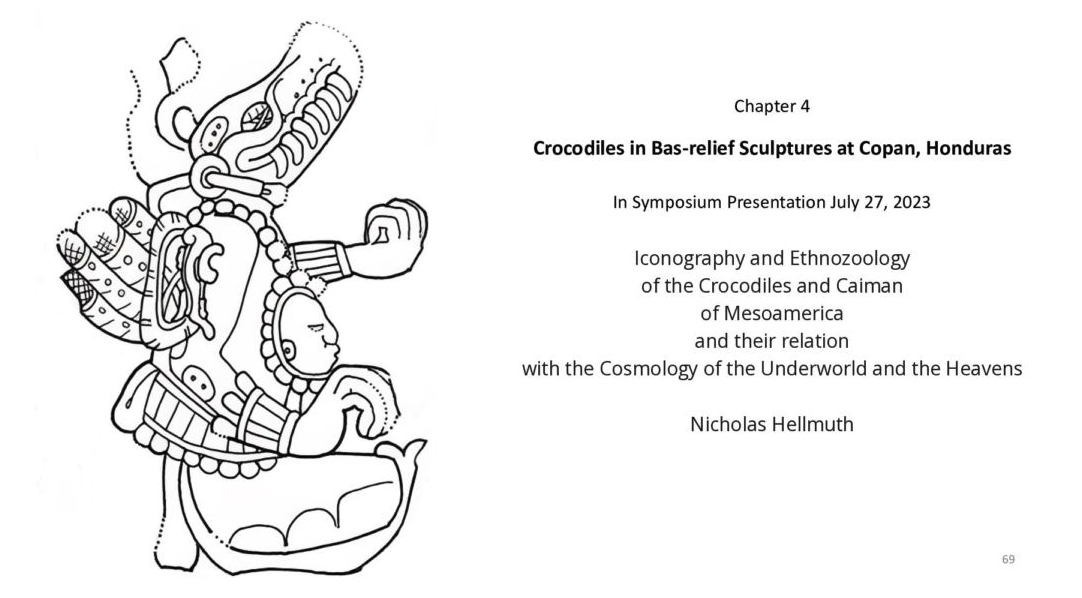Iconography is an important aspect of research in Maya archaeology studies
In our first visits to Maya archaeology sites we are impressed by their majestic temples, pyramids, palaces, acropolises and ballcourt architecture. But gradually many of us develop a desire to learn what do the symbols mean that decorate the buildings.
Same with Classic Maya art: it is beautiful, impressive and we enjoy seeing pre-Columbian art at museum exhibits and in coffee-table books. But gradually many of us get the inspiration to learn what are these symbols. Iconography is the study of symbols, study of motifs, study of decorations. Epigraphy is the study of Maya hieroglyphic writing. The research and publications of FLAAR are on Maya architecture, flora, fauna and ecosystems associated with Maya archaeology, and on iconography of Maya archaeology and the use of photography to document Maya sculptures. At Copan, Honduras we have studied the trees with bark like a crocodile tree, leaf-cutting ants (that are featured with the Hero Twins in the Popol Vuh), the happy friendly scarlet macaws, the butterflies nearby, ballcourt architecture, and iconography on the stelae, altars and architectural decorations of the buildings of Copan
 |
 |
After immersing myself in Maya architecture, especially Puuc, Chenes and Rio Bec regional architectural styles of Yucatan, Campeche and Quintana Roo, Mexico, I began to study Classic Maya art. I started out by studying which fish, flowers, mammals, reptiles, insects and arachnids are in Classic Maya art. Still today in 2023 we are studying monkeys, crocodiles, waterbirds in remote parts of the Maya Lowlands of Guatemala.
|
|
This “multi-ton” Copan altar CPN 25 has lots of devils, demons and deities to learn about. This first edition FLAAR Report is to make the photos available, so is not an iconographic analysis but at least we do show that:
- The overall sculpture is a bicephalic Cosmic Monster
- Front head is a crocodile, but with Starry Ears (instead of Starry Eyes)
- A God N sticks out the open mouth of the crocodile (common but not always)
- Legs are deer legs and deer hooves (as typical for Cosmic Monsters)
- Quadriparte Badge Headdress at the tail end (as typical for Cosmic Monsters)
- Cauac Monster (often called Witz Monster) on each side (atypical for Cosmic Monster)
- Complete frontal head at top (similar yet different than the faces on the sides). It is not usual for a Cosmic Monster to have the entire top as a monster face looking upward.
I do not yet have a photograph of the top of this Maya altar from above, but you can see the top from above in the excellent 3D scan that can be downloaded from various pages of SketchFab.com. One calls it Altar M, Parque Arqueológico Copán Ruinas. I estimate that the actual scans are by Atsushi Noguchi, The Center for Next Generation Archaeological Studies, Komatsu University.
The shared features and the different features of the top compared with the two Cauac Monster (Witz Monster) on the side is an entire MA thesis unto its own. My goal is to show the sculpture, provide a bibliography, and thereby have our FLAAR Photo Archive available to students, professors around the world and available to everyone at Copan Ruinas, Honduras.
To learn more about caiman and crocodiles in Mesoamerica, and to learn about crocodiles in Classic Maya art, below are two introductions. It is best never to use the word alligator for Mesoamerica.
 |
Here is a link to our comprehensive discussion of Cosmic Monsters at Copan, Piedras Negras and elsewhere. This is chapter 6 |
More to come during September and October (2023) from years of photography at Copan, Honduras
Our long-range goal is to find all our 35mm color slides (using Leica camera) and medium format film photos (using Hasselblad camera) of Maya stelae and altars at Copan archaeology park and museums in Copan Ruinas of the 1960’s-1990’s) and scan at good resolution. And simultaneously to find all our digital photographs from circa 1998-2015 that we have taken at the ruins and museums of Copan, Honduras. Once we have all the digital images we will then sort them into topics so we can present the images topic-by-topic. Most of these publications will be in 2024 because we are still working on flora, fauna, and biodiverse ecosystems of the Reserva de la Biosfera Maya, Peten, Guatemala. But during the rainy season, when you can’t fly a drone due to weather and the roads are too deep in mud even for a 4x4 pickup truck, we are working on preparing our decades of photography at Copan Ruinas. Below we list the first eight topics (lots more to come), plus we are looking for our Nim Li Punit stelae photos, our Santa Rosa Xtampak, Campeche Puuc-Chenes-Rio Bec regional Maya architecture photos, and lots more).
Cauac Monster, Cosmic Monster with Quadripartite Badge Headdress, Crocodile, Deer and God N, Copan CPN 25, Altar of Stela M
FLAAR Photo Archive Publication Number 1,
Maya Sculptures of Copan, Honduras, Publication Number 1
Scorpion, Venus, Moon Goddess with Rabbit Companion,
Celestial Deities on Sky Band Motifs on Copan Structure 8N-66C Bench Front
FLAAR Photo Archive Publication Number 2,
Maya Sculptures of Copan, Honduras, Publication Number 2
Copan Ceramic Incensario Lids, Local adaptation of Teotihuacan Style
Volume I, Photos in full-page Height, Horizontal Format
FLAAR Photo Archive Publication Number 3,
Maya Ceramics of Copan, Honduras, Publication Number 1A
Copan Ceramic Incensario Lids, Local adaptation of Teotihuacan Style
Volume II, Vertical Format
FLAAR Photo Archive Publication Number 4,
Maya Ceramics of Copan, Honduras, Publication Number 1B
Glyphs on front of throne Str. 9N-82
FLAAR Photo Archive Publication Number 5,
Maya Sculptures of Copan, Honduras, Publication Number 3
Beards on Kings of Copan
FLAAR Photo Archive Publication Number 6,
Maya Sculptures of Copan, Honduras, Publication Number 4
Paddler God Faces and Hieroglyphs at Copan
FLAAR Photo Archive Publication Number 7,
Maya Sculptures of Copan, Honduras, Publication Number 5
Cauac Monsters at Copan, especially in Stacks on Corners of Palaces and Mythical Structures
FLAAR Photo Archive Publication Number 8,
Maya Sculptures of Copan, Honduras, Publication Number 6
First posted September 8, 2023 by Nicholas Hellmuth































